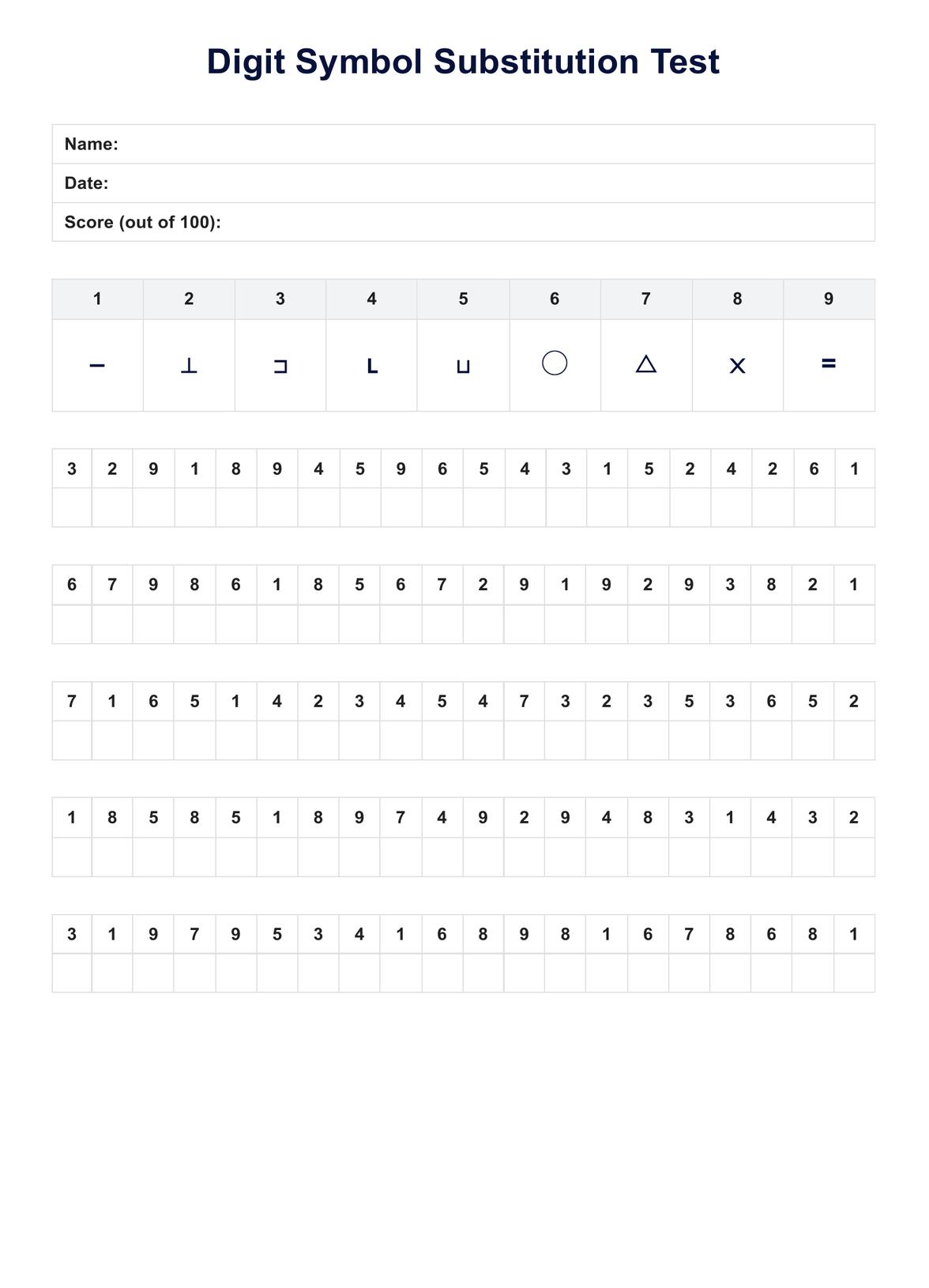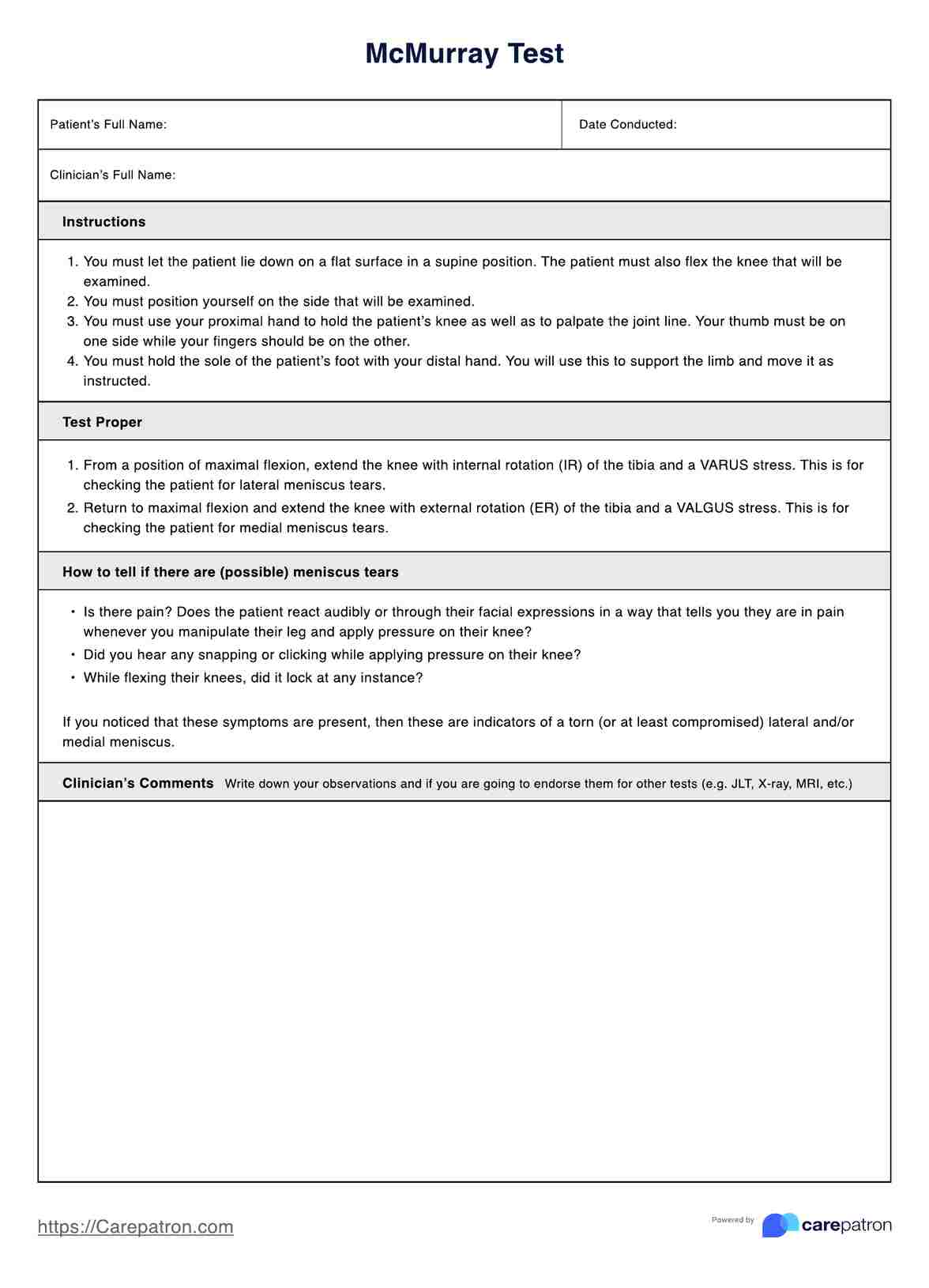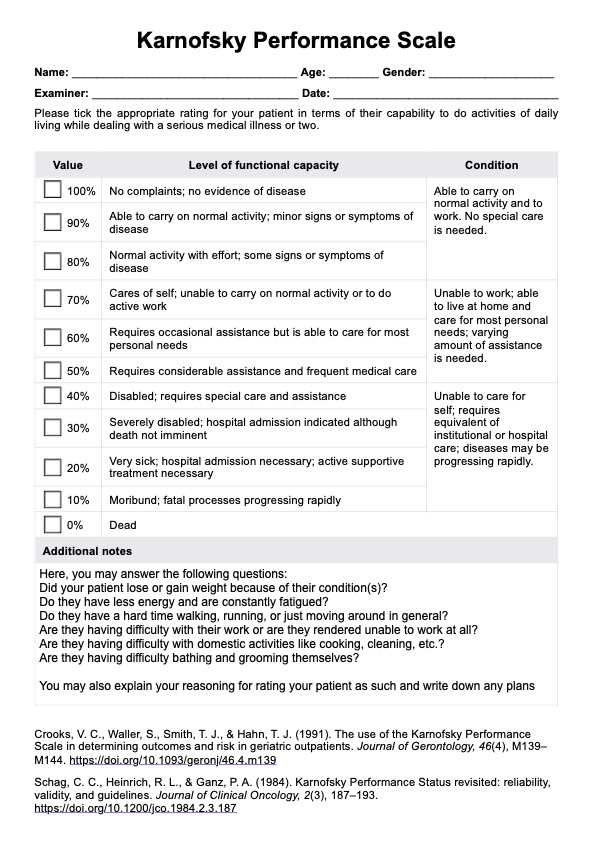Thigh Thrust Test
Learn about the Thigh Thrust Test, a diagnostic tool in healthcare to assess hip joint pathology and potential causes of hip pain.


What is the sacroiliac joint?
The sacroiliac joint (SI joint) connects the spine to the pelvis. It is formed by the sacrum and the ilium bones and is surrounded by strong ligaments, providing stability and support to the lower back and hips. Sacroiliac joint dysfunction can lead to sacroiliac joint pain, often characterized by discomfort in the lower back, buttocks, and thighs.
Diagnosing sacroiliac joint pain can be challenging but typically involves a comprehensive clinical examination, including sacroiliac pain provocation tests. These tests, such as the compression test, aim to reproduce the patient's symptoms and assess the joint's functionality. Positive tests indicate a higher likelihood of sacroiliac joint dysfunction, while negative tests may suggest alternative causes for the pain.
The SI joint serves several essential functions in the human body:
- Stability: The sacroiliac joint (SI joint) provides stability to the pelvis by connecting the sacrum and the ilium bones, ensuring proper alignment and support for the lower back and hips.
- Support: This joint plays a pivotal role in supporting the weight of the upper body and facilitating movements such as walking, standing, and sitting, promoting overall biomechanical integrity.
- Shock absorption: By absorbing shock and distributing forces between the spine and the lower extremities, the SI joint helps minimize the impact of physical activities on the body, reducing the risk of injury.
- Weight transfer: It assists in transferring weight from the upper body to the lower body, ensuring balanced weight distribution and minimizing strain on surrounding muscles, ligaments, and joints.
- Functional movement: Properly functioning of the sacroiliac joint is essential for maintaining functional movement patterns and preventing compensatory mechanisms leading to pain and dysfunction.
- Clinical evaluation: Healthcare professionals use pain provocation tests, such as the thigh thrust test, to assess the function and integrity of the sacroiliac joint, aiding in diagnosing and managing sacroiliac joint pain and dysfunction.
Understanding the positive predictive value (PPV) and negative predictive value (NPV) of sacroiliac pain provocation tests is essential for accurate diagnosis. A positive test result indicates a high likelihood of sacroiliac joint dysfunction, increasing confidence in the diagnosis. Conversely, a negative test result reduces the likelihood of sacroiliac joint involvement, guiding clinicians toward other potential sources of pain. Healthcare professionals can effectively diagnose sacroiliac joint pain through clinical examination and appropriate testing and tailor treatment plans to alleviate discomfort and improve patient outcomes.
Thigh Thrust Test Template
Thigh Thrust Test Example
What is sacroiliac dysfunction?
Sacroiliac dysfunction refers to an impairment or malfunction of the sacroiliac joint (SI joint), which can result in pain and discomfort in the lower back, buttocks, and thighs. It often manifests as chronic low back pain that may worsen with certain movements or activities. Diagnosis typically involves a comprehensive medical history review and physical examination, including provocative tests like compression and Patrick's tests.
During a compression test, the clinician applies downward pressure on the pelvis while the patient lies supine. A positive test elicits pain in the SI joint area, indicating potential dysfunction. Patrick's test, also known as the FABER test, involves the patient lying on their back with one ankle resting on the opposite knee, followed by outward pressure applied to the flexed knee. Positive findings in these tests suggest sacroiliac joint involvement.
Proper diagnosis of sacroiliac dysfunction is essential for developing effective treatment strategies. By conducting thorough physical examinations and employing appropriate provocative tests, healthcare professionals can accurately identify sacroiliac dysfunction and provide targeted interventions to alleviate symptoms and improve patient's quality of life.
What is the Thigh Thrust Test?
The Thigh Thrust Test, a vital component of sacroiliac pain provocation tests, aids in diagnosing sacroiliac joint dysfunction, a common source of chronic low back pain. Conducted by a healthcare professional, this test involves the patient lying on their back with the examiner standing on the side being assessed. The examiner then places one hand over the anterior superior iliac spine (ASIS) to stabilize the pelvis while the other hand is positioned over the knee of the same leg. Next, the examiner applies a controlled anterior thrust force through the femur, directing it toward the sacroiliac joint.
During the Thigh Thrust Test, the examiner observes for any reproduction of the patient's sacroiliac joint pain. A positive test result is indicated by eliciting pain localized to the sacroiliac joint or surrounding area. This response suggests potential sacroiliac joint involvement in the patient's symptoms. The test is typically performed bilaterally to compare the patient's responses on both sides, providing valuable information for diagnosis and treatment planning.
The Thigh Thrust Test is a reliable method for assessing sacroiliac joint pain, contributing to a comprehensive evaluation of individuals presenting with chronic low back pain. By utilizing this thrust test and other individual provocation tests, healthcare providers can effectively identify and differentiate sacroiliac joint dysfunction from different sources of lumbar spine pathology. This aids in tailoring targeted interventions to reduce pain and improve overall function for patients suffering from sacroiliac joint-related discomfort.
When do professionals conduct this test?
Healthcare professionals conduct the Thigh Thrust Test in various instances to assess sacroiliac joint dysfunction, particularly when patients present with symptoms suggestive of sacroiliac joint pain. Here are scenarios when this test is necessary:
- Chronic low back pain evaluation: When patients complain of persistent low back pain, especially if it's localized to the sacroiliac joint area, healthcare providers may perform the Thigh Thrust Test as part of the diagnostic process.
- Differential diagnosis: In cases where the cause of low back pain is unclear, professionals may utilize the Thigh Thrust Test along with other individual provocation tests to distinguish between sacroiliac joint dysfunction and other lumbar spine pathologies.
- Treatment planning: Before initiating treatment for sacroiliac joint pain, clinicians may conduct the Thigh Thrust Test to confirm the involvement of the sacroiliac joint, guiding the selection of appropriate interventions aimed at pain management and functional improvement.
- Follow-up assessment: After implementing therapeutic interventions such as manual therapy or exercise programs, professionals may repeat the Thigh Thrust Test to evaluate the effectiveness of treatment and monitor any changes in sacroiliac joint function.
- Pre-surgical evaluation: For patients considering surgical interventions for sacroiliac joint dysfunction, the Thigh Thrust Test may be performed to confirm the need for surgical intervention and to guide preoperative planning.
What are the next steps after conducting this test?
After conducting the Thigh Thrust Test to assess sacroiliac joint dysfunction, healthcare professionals proceed with several crucial next steps to further evaluate and manage the condition. Firstly, they may perform additional sacroiliac pain provocation tests, such as the compression test or distraction test, to corroborate the findings and enhance diagnostic accuracy. These tests help confirm the involvement of the sacroiliac joint and distinguish it from other sources of low back pain.
Following a positive test result indicating sacroiliac joint dysfunction, clinicians then tailor treatment plans based on the patient's specific needs and goals. Treatment options may include a combination of conservative therapies such as physical therapy, chiropractic care, and pain management techniques. Additionally, education on proper posture and body mechanics may be provided to prevent exacerbation of symptoms.
How does our Thigh Thrust Test template work?
Our Thigh Thrust Test template provides a structured framework for healthcare professionals to administer and document the Thigh Thrust Test accurately and efficiently. Here's how it works:
Step 1: Patient information collection
Healthcare professionals gather essential patient information, including name, age, gender, and contact details. This ensures proper identification and documentation of the individual undergoing the Thigh Thrust Test.
Step 2: Test procedure execution
During the test procedure, practitioners systematically position the patient, stabilize the pelvis, and apply a controlled anterior thrust force through the femur toward the sacroiliac joint. This standardized procedure helps ensure consistency and reliability in test administration.
Step 3: Observation and interpretation
Following the test execution, healthcare professionals carefully observe the patient's response for any reproduction of sacroiliac joint pain or discomfort. Positive test results indicate potential sacroiliac joint dysfunction, while negative results suggest otherwise. Interpretation of test findings is crucial for accurate diagnosis and treatment planning.
Step 4: Documentation and clinical implications
Once the test is completed, practitioners document relevant observations, including pain intensity, location, and any additional tests performed. Clinical implications are then considered, such as the need for further evaluation or treatment based on test results.
Step 5: Completion and follow-up
Finally, healthcare professionals sign off on the documentation, indicating that the Thigh Thrust Test has been completed. Follow-up may be scheduled to monitor the patient's progress or adjust treatment plans.
Following these steps, our Thigh Thrust Test template facilitates standardized administration, documentation, and interpretation of test results, ultimately enhancing clinical decision-making and patient care.
What are the benefits of conducting this test?
The Thigh Thrust Test offers numerous benefits in the assessment of sacroiliac joint dysfunction and related conditions:
- Diagnostic accuracy: It aids in accurately diagnosing sacroiliac joint dysfunction by reproducing characteristic symptoms, enhancing the validity of clinical assessments.
- Patient-specific treatment: Positive test results guide healthcare professionals in tailoring individualized treatment plans for patients, optimizing outcomes and patient satisfaction.
- Clinical efficiency: The test is quick and easy to administer, allowing for efficient evaluation of sacroiliac joint involvement in patients with low back pain.
- Complementary tool: When used in combination with other sacroiliac pain provocation tests, such as the compression test and distraction test, the Thigh Thrust Test enhances the reliability and diagnostic utility of the assessment.
- Evidence-based practice: Incorporating the Thigh Thrust Test into clinical practice aligns with evidence-based guidelines for the evaluation of sacroiliac joint dysfunction, ensuring high-quality care delivery to patients.
Treatment options for sacroiliac joint problems
Treatment of sacroiliac joint problems involves various approaches to alleviate pain and improve function. These include:
- Physical therapy: Customized exercises and manual therapy techniques strengthen muscles and enhance flexibility around the joint.
- Medication: Nonsteroidal anti-inflammatory drugs (NSAIDs) and muscle relaxants help manage pain and inflammation. Corticosteroid injections may offer temporary relief.
- Activity modification: Adjusting activities and maintaining proper posture reduce stress on the joint.
- Bracing: Supportive belts or braces can stabilize the joint and alleviate discomfort.
- Education: Patient education on self-management strategies and pain coping techniques is crucial.
- Minimally invasive procedures: Injections or radiofrequency ablation may be considered for persistent pain when conservative measures are insufficient.
A tailored approach combining these strategies is essential for effective management of sacroiliac joint problems and improved quality of life.
Capitalizing on this Faber test template and circle of control worksheet template can strengthen your practice and client results.
Why use Carepatron as your orthopedic and physical therapy software?
Carepatron excels as a leading orthopedic and physical therapy software, offering a robust suite of features tailored to streamline workflows and enhance patient care.
With its advanced physical therapy EMR system, Carepatron enables practitioners to efficiently manage electronic patient records, documenting encounters, treatment plans, and assessments with ease. Its clinical documentation software goes beyond basic record-keeping, providing sophisticated tools for data analysis and outcome measurement.
Carepatron prioritizes interoperability, seamlessly connecting with other systems and platforms to enhance communication and collaboration among multidisciplinary care teams.
By choosing Carepatron, healthcare providers can optimize workflows, improve clinical outcomes, and deliver superior care to their patients in orthopedic and physical therapy settings.
Take the next step towards enhancing your practice with Carepatron today!

Commonly asked questions
During the Thigh Thrust Test, the patient lies supine on a treatment table while the examiner stands on the side being assessed. The examiner stabilizes the pelvis with one hand over the anterior superior iliac spine (ASIS) and applies an anterior thrust force through the femur using the other hand positioned over the knee.
A positive Thigh Thrust Test result is indicated by reproduction of pain localized to the sacroiliac joint or its surrounding area. This response suggests potential sacroiliac joint involvement in the patient's symptoms, indicating sacroiliac joint dysfunction.
A positive Thigh Thrust Test may indicate sacroiliac joint dysfunction, prompting further evaluation and treatment planning. It provides valuable diagnostic information for healthcare professionals to tailor targeted interventions aimed at reducing pain and improving function.


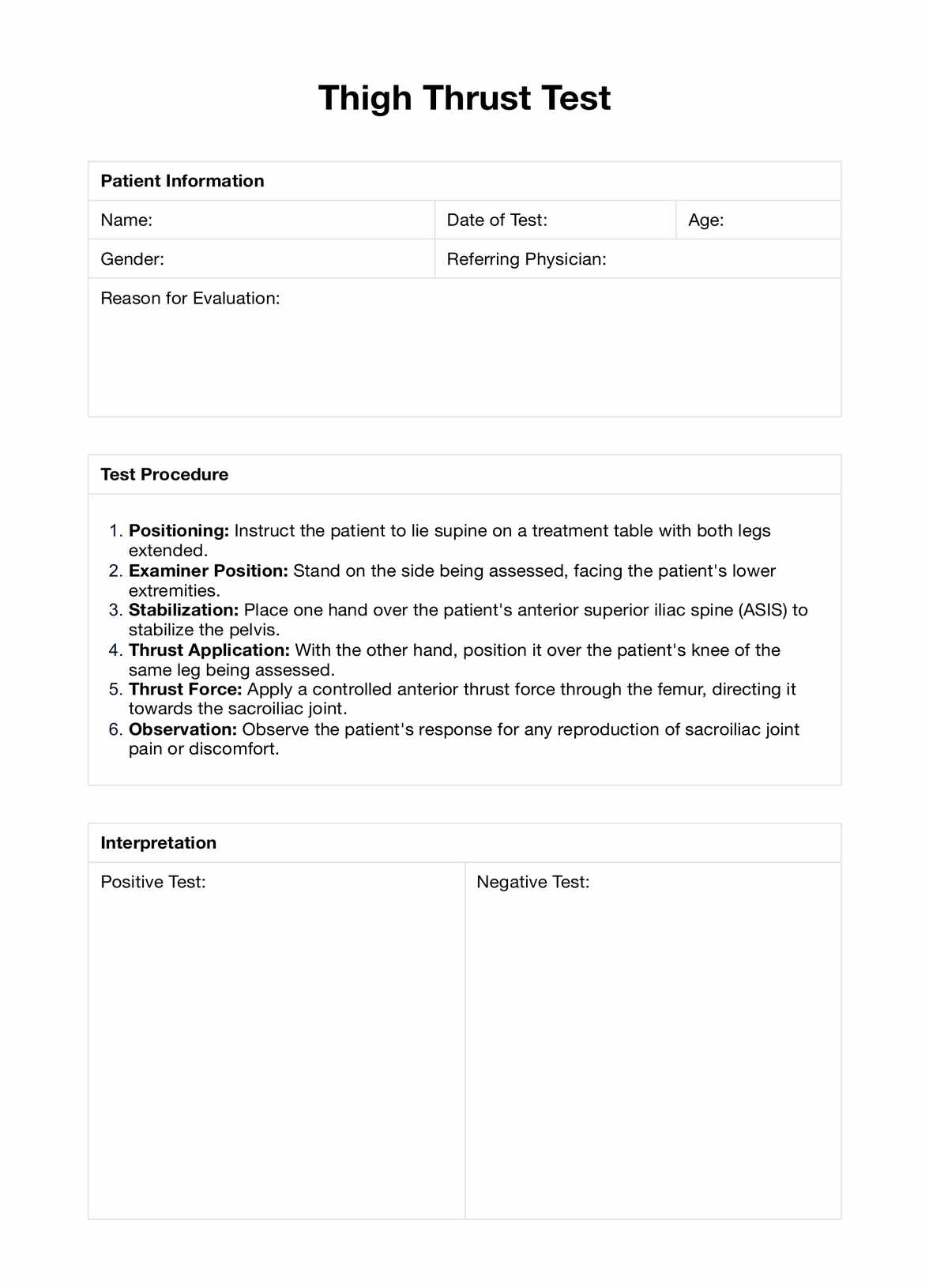
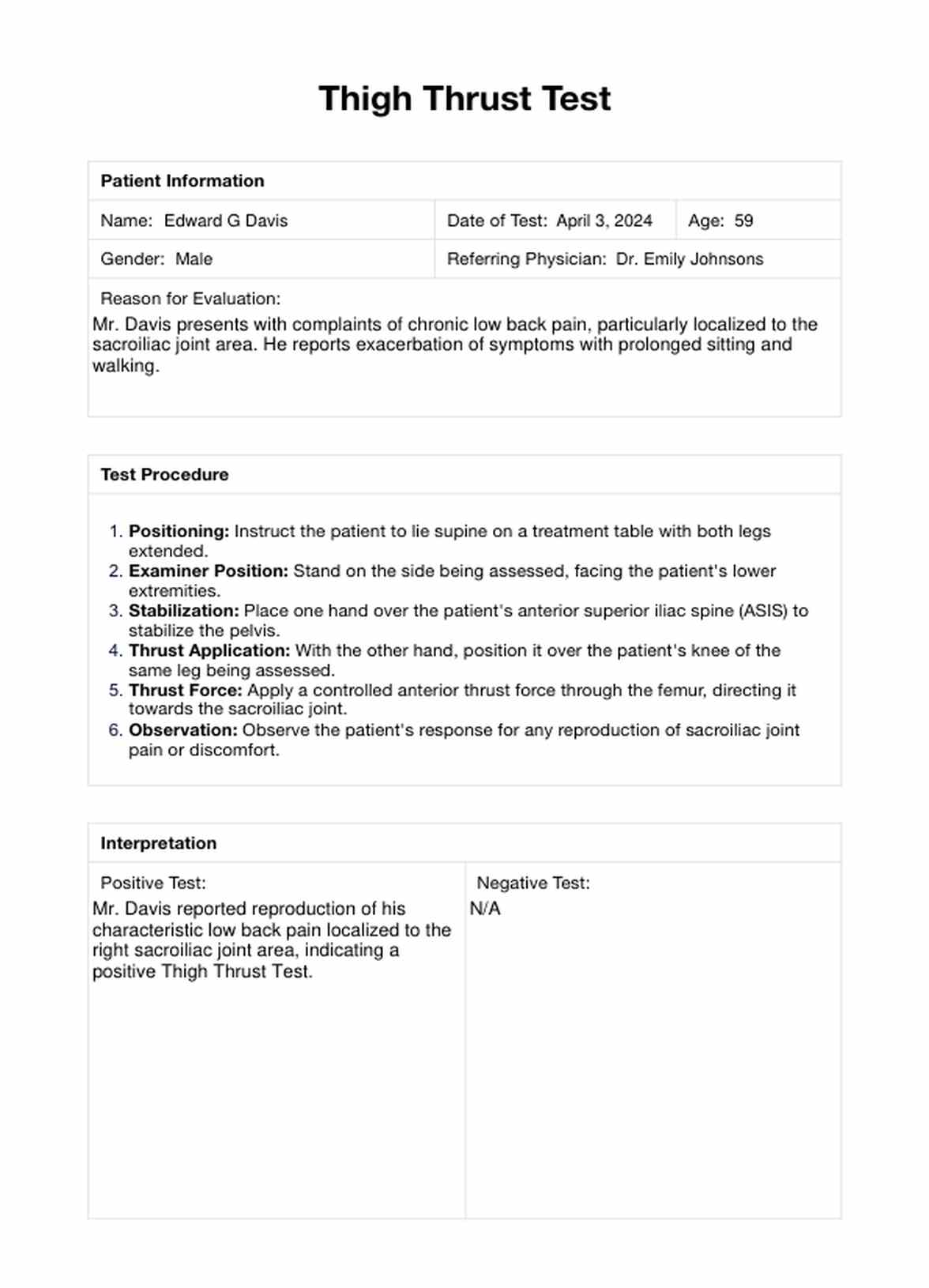


















-template.jpg)
























































































